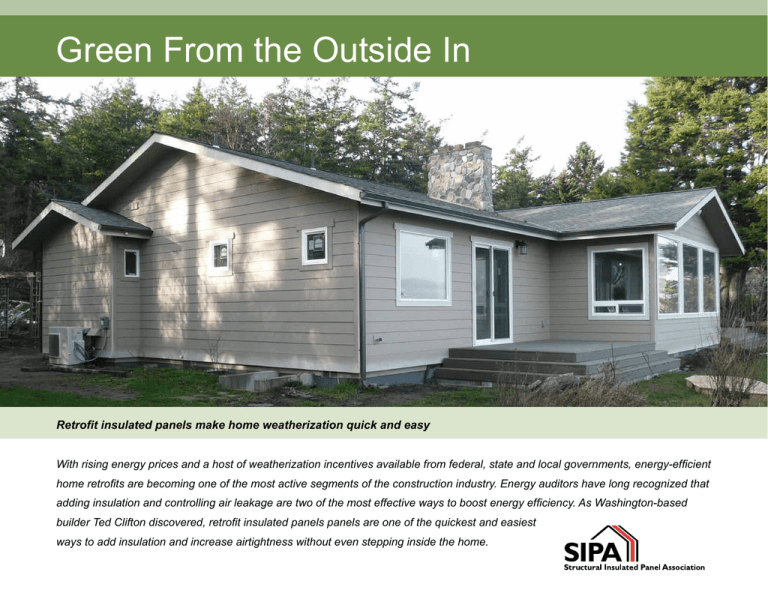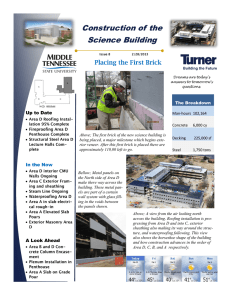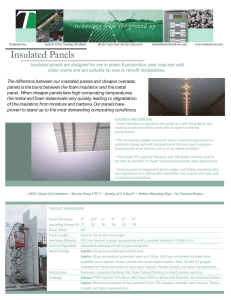
Green From the Outside In
Retrofit insulated panels make home weatherization quick and easy
With rising energy prices and a host of weatherization incentives available from federal, state and local governments, energy-efficient
home retrofits are becoming one of the most active segments of the construction industry. Energy auditors have long recognized that
adding insulation and controlling air leakage are two of the most effective ways to boost energy efficiency. As Washington-based
builder Ted Clifton discovered, retrofit insulated panels panels are one of the quickest and easiest
ways to add insulation and increase airtightness without even stepping inside the home.
1
www.sips.org
PROJECT AT A GLANCE
Location:
Builder:
Oak Harbor, WA
CVH Inc.
square footage:
2,900
SIP Manufacturer:
Premier Building Systems
A longtime builder and construction educator, Ted Clifton has been building and remodeling
homes for more than 45 years. Energy-efficient homes are his specialty and he received the Energy
Value Housing Award from the Department of Energy in 2009 and 2010 for custom homes he built in
Coupeville, Washington.
In 2009, Clifton was approached by a friend who had recently purchased a home in Oak Harbor,
Washington with an excellent view of Skagit Bay.
“They loved the location but they really didn’t like the floor plan, and the house had some plumbing issues that would require a serious remodel,” said Clifton. “They asked if we could make the house
energy-efficient during the process.”
The homeowners actually considered a complete tear down of the 2,900-sq.-ft. rambler, but Clifton
calculated that he could remodel the home for a fraction of the cost using retrofit insulated panels on
the exterior of the home to provide air sealing and additional insulation.
Retrofit insulated panels are
easily installed over the
existing sheathing and sealed
to create a complete air barrier
2
www.sips.org
(Left) Installation crews created an
airtight envelope using expanding foam
between panels and around window
openings. (Below) Specialty SIP screws
were used to attach retrofit insulated
panels to the existing studs.
Retrofit insulated panels are a panelized insulation product made of expanded
polystyrene (EPS) foam laminated to oriented strand board (OSB) sheathing. The
EPS provides continuous insulation at roughly R-3.6 per inch, while the OSB creates
a nailing surface for exterior finishes or roofing.
Clifton stripped the siding off the home and applied 4-inch-thick, R-14 retrofit insulated panels to the entire exterior of the home. He ordered the panels from nearby
manufacturer Premier Building Systems in 9-foot lengths to cover the entire height
of the exterior walls and the rim joist area.
“What is great about retrofit panels is that you get air sealing as well as insulation,” said Clifton. “We were able to cover the rim joist, which is typically a major
source of air leakage in older homes.”
Retrofit insulated panels serve as an effective air barrier due to the low permeability of the OSB sheathing. Clifton’s crew used spray foam sealant between each
panel and around window openings to create a complete air barrier.
Combined with other improvements, including new windows, attic insulation,
HVAC system and other air sealing measures, Clifton was able to reduce the home’s
annual heating cost by 83.5 percent.
3
www.sips.org
Time and Labor Savings
Although Clifton gutted the house to modify the interior floor plan and address the
plumbing issues, he points out that retrofit insulated panels allow insulation to be added
to the walls of the home without requiring work on the interior.
“I want to emphasize that we can do this type of installation entirely from the outside without going inside the home,” he said. “It is a major advantage for people who
want to weatherize their house but don’t want a crew inside their home.”
Clifton’s crews fabricated the panels onsite to fit around the existing doors and
windows. The panels are sized to correspond with dimensional lumber so that blocking can be inserted around window and door openings. Clifton attached the panels to
the existing studs using specially designed 6-inch screws commonly used in structural
insulated panel installation.
“With retrofit insulated panels, you get a higher R-value and a quicker application
than the alternatives,” said Clifton. “It is economical for both materials and labor.”
Nearly any type of siding or exterior finish can be applied over retrofit insulated
panels. Clifton has attached everything from cementitious siding to brick veneer. He
has also used the product to add insulation to residential roofs.
“If a house needs a new roof, we can rip the old roofing off, add ten to twelve
inches of insulation, and screw it down to the existing trusses,” he said. “We then seal
all the existing soffit vents with spray foam and close in that attic as part of the thermal
envelope.”
For builders unfamiliar with retrofit panels, Clifton says that with minimal training
anyone can undertake a deep energy retrofit.
“I would recommend that builders get some experience or find someone experienced with retrofit insulated panels and go for it,” he said. “You’ll find that you can be
very cost effective doing deep energy retrofits with this product.”
Retrofit insulated panels are available from most structural insulated panel manufacturers. For a list of manufacturers in your area, visit www.sips.org.
4
www.sips.org
Installing retrofit insulated panels, roof
insulation and new windows helped cut
the home’s heating cost by 83.5 percent
www.sips.org
P.O. Box 1699, Gig Harbor, WA 98335
p: 253.858.7472
f: 253.858.0272
5
www.sips.org
Copyright © 2010 Structural Insulated Panel Association (SIPA). All rights reserved.




